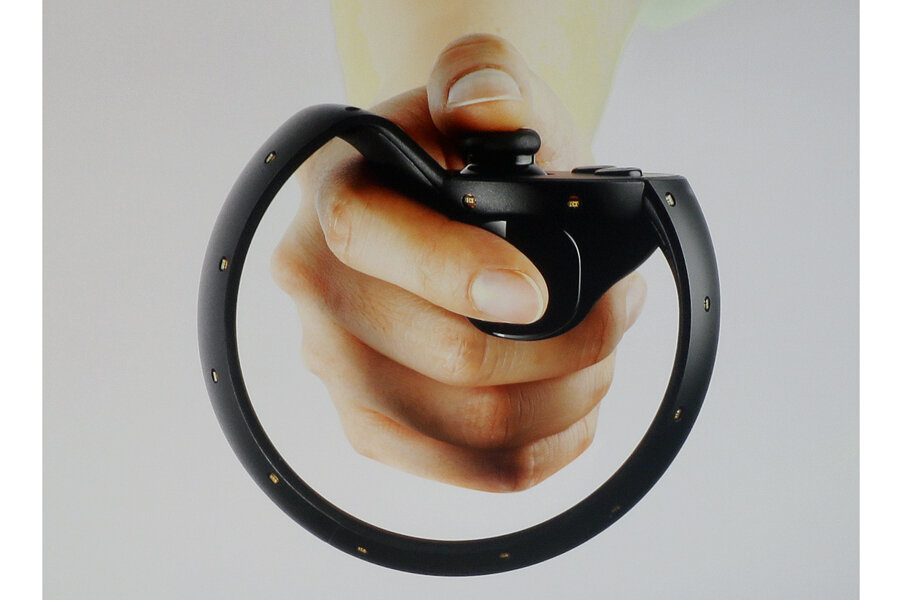Will Oculus Touch be as groundbreaking as the Rift?
Loading...
When Oculus VR launched a Kickstarter campaign in 2012, it promised the first virtual-reality goggles that live up to science fiction. The start-up capitalized on the fact that smart phones had driven down the price of small, high-quality screens and sensors – the parts necessary to build a headset that not only presents a realistic 3-D world, but also can accurately track your head as you peered into it.
After three years of refinements and a $2 billion acquisition by Facebook, Oculus revealed its first consumer pair of VR goggles on Thursday at a press conference in San Francisco. This completed headset, called the Oculus Rift, will go on sale early next year.
Going into its big unveiling, Oculus had already proven that it could deliver two of the three pieces necessary to create an immersive VR experience.
The company has already sent out thousands of prototype headsets to Kickstarter backers and sold others to developers interested in trying out the hardware. These early goggles attracted rave reviews, so there was little doubt that Oculus could build a headset for regular consumers.
Developers have flocked to the Oculus Rift, creating games, 3-D movies, and professional software, such as VR models for architecture firms. Few questioned whether Facebook could convince developers to continue making fun, interesting, and – perhaps – important software for the Rift. And, indeed, several major companies got on stage with Oculus. Phil Spencer, head of Microsoft's Xbox division, told the crowd on Thursday that gamers will be able to play Xbox One games on a Rift. The Oculus team also mentioned Harmonix, creators of Rock Band; Square Enix, the publisher behind Tomb Raider and Final Fantasy; and CCP, which showed off a spaceship simulator called EVE: Valkyrie.
The final piece of the puzzle for Oculus was how people would interact with these 3-D worlds. The Rift is incredibly accurate, but the headset doesn't know where your hands or body are. It only tracks your head. So aside from simply looking around, how will people move and touch in VR? With keyboards? Video game controllers? Something new?
After Oculus convinced investors that quality virtual reality was around the corner, several competing headsets popped up. One of the most interesting rivals has been Vive, a partnership between HTC, the Taiwanese gadgetmaker, and Valve, a Seattle company which runs one of the largest online stores for computer games. The Vive goggles look very similar to the Rift, but before Thursday, many reviewers argued that HTC had outperformed Oculus in terms of how people interact with the virtual worlds. Vive's technology relies on "Lighthouses," small ground stations placed around a room. These boxes track the location of each pair of goggles, controllers, or other objects with sub-millimeter precision 100 times a second. This means that 10 players could walk around a room with special controllers in hand, reach for virtual objects, and pick them up by griping the controller – all without fear of people bumping into each other or outstretched hands overshooting their target.
While most early Oculus demos had a person sitting down with their hands on a video game controller, Vive opened up the opportunity for people to get up, reach out, and interact in more natural ways.
Oculus answered these doubts on Thursday with a controller of its own. Oculus Touch looks like a video game controller snapped in half with a ring of sensors that encircle each of a player's hands. Palmer Luckey, Oculus founder, says the Touch combines motion controls with physical buttons and haptic feedback such as vibrations. He says the controller can also read finger gestures, "such as pointing, waving, or giving a thumbs up."
The Touch will not be available during the initial launch of the Rift next year, according to Engadget. Oculus plans to make the Touch available to developers first and begin selling the controller later in 2016. In the meantime, the Rift will come with an Xbox One controller. Current Rift games already work with standard computer controls, such as keyboards, mouses, and joysticks.
For more on how technology intersects daily life, follow Chris on Twitter @venturenaut.





